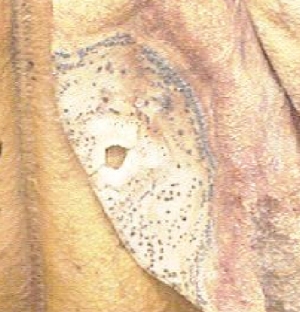Volutella blight of Pachysandra
 Causal Agent
Causal Agent
Volutella pachysandrae, V. pachysandricola
Hosts
Pachysandra.
Symptoms
Early symptoms include circular or irregular spots on the leaves. As the disease progresses, the spots enlarge and often have a "bulls-eye" appearance. Frequently, the entire leaf turns brown and drops off. If the disease is severe, the stems often develop elongated cankers which girdle the stem and can result in blighting (wilts and turns brown) of the entire shoot. Under humid conditions, the blighted leaves may have a peach-orange tint due to the pathogen's spores. The spores can be blown or splash to new leaves and spread the infection.
Control

Severely infected plants and fallen leaves should be removed and discarded (not composted). Blighted shoots should be removed by pruning and discarded. Care should be taken to disinfest pruning tools in a disinfectant (such as 10% bleach) between plants to limit spreading the disease.
Overhead watering should be avoided or limited to late morning. This will decrease the period of leaf wetness since the leaves will dry quickest during this time of the day. Plantings in the ground should be thinned by pruning to increase air circulation and to promote drying of the leaves and stems. If the plants are in containers, the pots should be more widely spaced to increase air movement between plants.
Plants that are weak or under stress are more susceptible to Volutella leaf blight. Possible stress factors include inadequate light, drought, winter injury or poor nutrition.
Even after cultural control methods are employed, it is often necessary to use fungicides to control Volutella leaf blight. Please contact your local county extension office for current fungicide recommendations.

